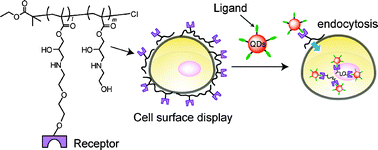Artificial polymeric receptors on the cell surface promote the efficient cellular uptake of quantum dots†
Abstract
In our previous paper, secondary-

* Corresponding authors
a
Research Institute for Electronic Science (RIES), Hokkaido, University, Kita21, Nishi10, Kita-Ku, Sapporo, Japan
E-mail:
kniikura@poly.es.hokudai.ac.jp
b Division of Chemistry, Graduate School of Science, Hokkaido University, Japan
c Graduate School of Information Science and Technology, Hokkaido University, Japan
d Faculty of Pharmaceutical Sciences, Tokyo University of Science, Yamazaki, Noda, Japan
In our previous paper, secondary-

 Please wait while we load your content...
Something went wrong. Try again?
Please wait while we load your content...
Something went wrong. Try again?
K. Niikura, K. Nambara, T. Okajima, R. Kamitani, S. Aoki, Y. Matsuo and K. Ijiro, Org. Biomol. Chem., 2011, 9, 5787 DOI: 10.1039/C1OB05420A
To request permission to reproduce material from this article, please go to the Copyright Clearance Center request page.
If you are an author contributing to an RSC publication, you do not need to request permission provided correct acknowledgement is given.
If you are the author of this article, you do not need to request permission to reproduce figures and diagrams provided correct acknowledgement is given. If you want to reproduce the whole article in a third-party publication (excluding your thesis/dissertation for which permission is not required) please go to the Copyright Clearance Center request page.
Read more about how to correctly acknowledge RSC content.
 Fetching data from CrossRef.
Fetching data from CrossRef.
This may take some time to load.
Loading related content
